Table of Contents
- Introduction
- Editor’s Choice
- Global Honey Market Overview
- Nutrition Facts About Honey
- Honey Constituents That Present Health-Promoting Effects And Nutritional Value
- Top Consumers of Honey in The World
- Honey Production Statistics
- Leading Honey Exporting Nations
- Leading Honey Import Nations Statistics
- Regulatory Guidelines for Honey
- Recent Developments
- Conclusion
- FAQs
Introduction
Honey Statistics: Honey, a sweet substance produced by bees from the nectar of flowers, is renowned for its extensive history of application in cooking, traditional remedies, and therapeutic practices.
Its composition consists of sugars like glucose and fructose, alongside water and other natural constituents.
Bees gather nectar from flowers using their proboscis and undergo a digestive process to convert it into honey. Various sorts of honey are accessible, each possessing a unique flavor influenced by the specific flowers bees visit.
People use honey as a natural sweetener in culinary dishes, appreciate its potential health benefits, and integrate it into both cosmetic products and cooking, owing to its inherent attributes.

Editor’s Choice
- In 2023, the global honey market recorded a revenue of USD 9.3 billion.
- Organic honey dominates the market with a commanding 78% market share. Indicating a strong preference among consumers for natural and sustainably produced honey products.
- The predominant component in honey is carbohydrates, making up 17.3 grams of its content.
- The consumption of honey per capita varies significantly across different countries. The Central African Republic leads the list by a considerable margin, with its citizens consuming an average of 9.62 grams of honey daily.
- In 2021, the global production of natural honey was led by China, emerging as the undisputed leader with an impressive production volume of 472.7 thousand metric tons.
- Leading the import list was the United States (U.S.A) with an impressive import quantity of 220,232 metric tonnes and a corresponding value of USD 667 million.
- The Codex Alimentarius Commission has established 15 parameters concerning honey standards. For instance, the moisture content in honey, except for heather honey, should not exceed 20%.
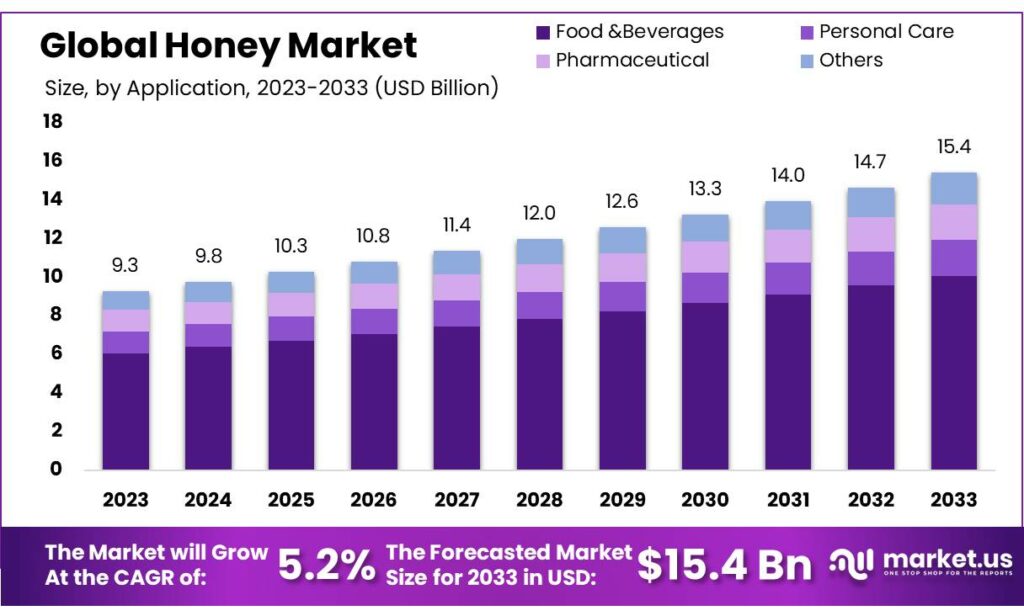
Global Honey Market Overview
Global Honey Market Size Statistics
- The global honey market is on a consistent upward trajectory at a CAGR of 5.2%. With revenue projections showcasing steady growth over the next decade.
- In 2023, the market recorded a revenue of USD 9.3 billion, which is expected to increase to USD 9.8 billion in 2024.
- This positive trend continues with estimated revenues of USD 10.3 billion in 2025, USD 10.8 billion in 2026, and USD 11.4 billion in 2027.
- The growth of the market can be attributed to various factors such as increasing consumer awareness of the health benefits of honey. Rising demand for natural and organic products, and expanding applications in the food and beverage industry.
- Furthermore, the market is forecasted to reach USD 12.0 billion in 2028, USD 12.6 billion in 2029, and an impressive USD 13.3 billion in 2030.
- This growth trajectory persists, with anticipated revenues of USD 14.0 billion in 2031 and USD 14.7 billion in 2032, culminating in a projected revenue of USD 15.4 billion by 2033.
- These statistics underscore the promising prospects and resilience of the global honey market. This aligns with the ongoing consumer preference for natural products and sustainable choices in the market.
(Source: Market.us)
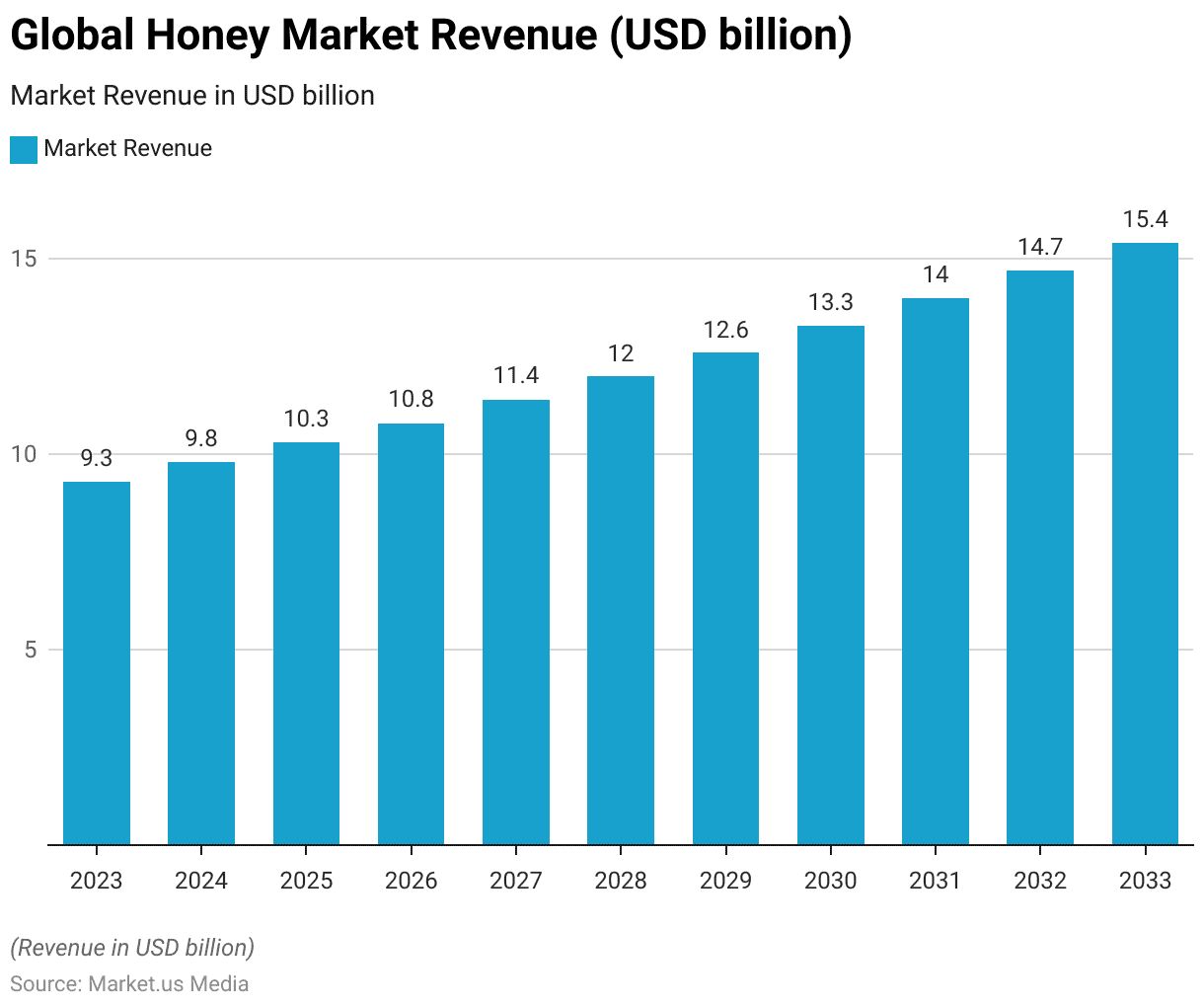
Global Honey Market Share – By Processing Statistics
- The global honey market is characterized by a significant market share disparity between different processing types.
- Organic honey dominates the market with a commanding 78% market share. Indicating a strong preference among consumers for natural and sustainably produced honey products.
- This robust market presence of organic honey reflects the growing awareness of health-conscious consumers who seek products free from synthetic chemicals and pesticides.
- In contrast, conventional honey holds a comparatively smaller market share, accounting for 22% of the overall market.
- This division in market share underscores the shifting consumer preferences towards healthier and environmentally responsible choices. Making organic honey a dominant force in the global honey market.
(Source: Market.us)
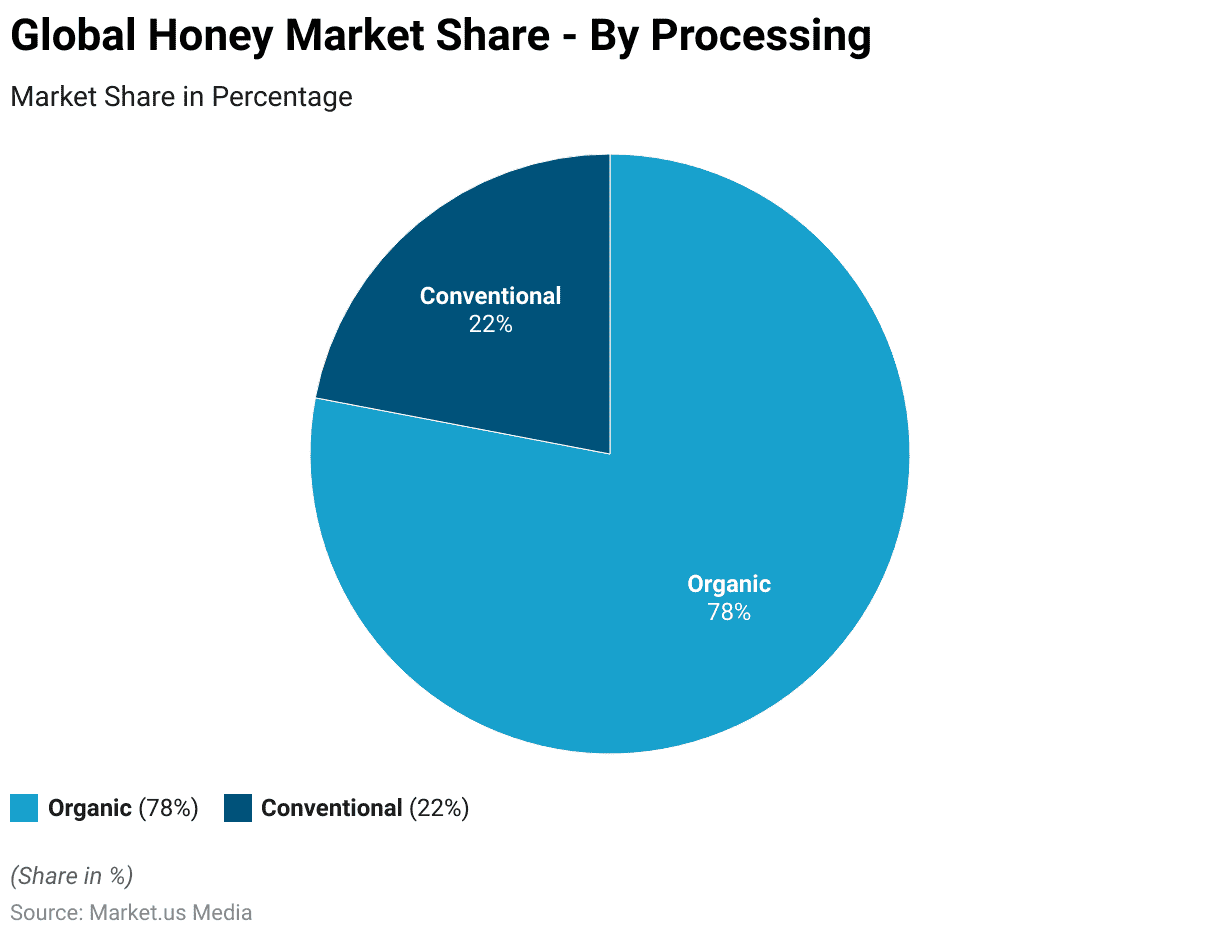
Nutrition Facts About Honey
- Honey, a natural and sweet substance, is not only known for its delightful flavor but also for its nutritional composition.
- In a single tablespoon (approximately 21 grams) of honey, it contains a minimal amount of protein, with just 0.06 grams. It is virtually fat-free, containing no total lipids (fat).
- The predominant component in honey is carbohydrates, making up 17.3 grams of its content.
- With an energy value of 63.84 kilocalories per tablespoon. Honey serves as a source of quick energy due to its high sugar content, with 17.25 grams of sugar in the same serving.
- While it doesn’t provide a significant amount of dietary fiber, with only 0.04 grams. Honey does offer trace minerals such as calcium (1.26 mg), iron (0.09 mg), magnesium (0.42 mg), phosphorus (0.84 mg), potassium (10.92 mg), and trace amounts of zinc (0.05 mg), copper (0.01 mg), manganese (0.02 mg), and selenium (0.17 mcg).
- In terms of vitamins, honey contains minimal amounts of vitamin C (0.1 mg), thiamin (0 mg), riboflavin (0.01 mg), niacin (0.03 mg), pantothenic acid (0.01 mg), vitamin B-6 (0.01 mg), and a small quantity of folate (0.42 mcg).
- Honey is cholesterol-free and does not contain significant amounts of saturated, monounsaturated, or polyunsaturated fats.
- Additionally, it does not provide vitamins A, E, B-12, K, retinol, or any notable carotenoids.
- Honey’s nutritional profile reflects its natural sweetness and serves as a versatile ingredient in a wide range of culinary applications while offering some trace minerals and a source of carbohydrates for energy.
(Source: University of Rochester Medical Center Rochester, New York)
Take advantage of our unbeatable offer - buy now!

Honey Constituents That Present Health-Promoting Effects And Nutritional Value
- Over the past few years, from 2015 to 2021, extensive research has shed light on the diverse constituents of honey and its potential health-promoting effects, reaffirming its nutritional value.
- Sugars and related compounds constitute a significant portion, accounting for 30% of honey’s composition. Which provides a sweet taste and serves as a source of energy.
- Amino acids and proteins make up 20%, offering essential building blocks for the body’s tissues and contributing to honey’s potential nutritional benefits.
- Lipids and related compounds, comprising 18%, provide some fats and lipid-based compounds, which. Although in smaller quantities, contribute to the overall nutritional profile.
- Vitamins, constituting 16%, impart essential micronutrients to honey, enhancing its appeal as a wholesome food.
- Phenolic compounds, at 8%, bring antioxidant properties and potential health benefits. While another 8% encompasses various other compounds, further diversifying honey’s nutritional content.
- These findings underscore the multifaceted nature of honey, emphasizing its value not only as a natural sweetener but also as a source of potential health benefits due to its rich and varied constituents.
(Source: Science Direct)
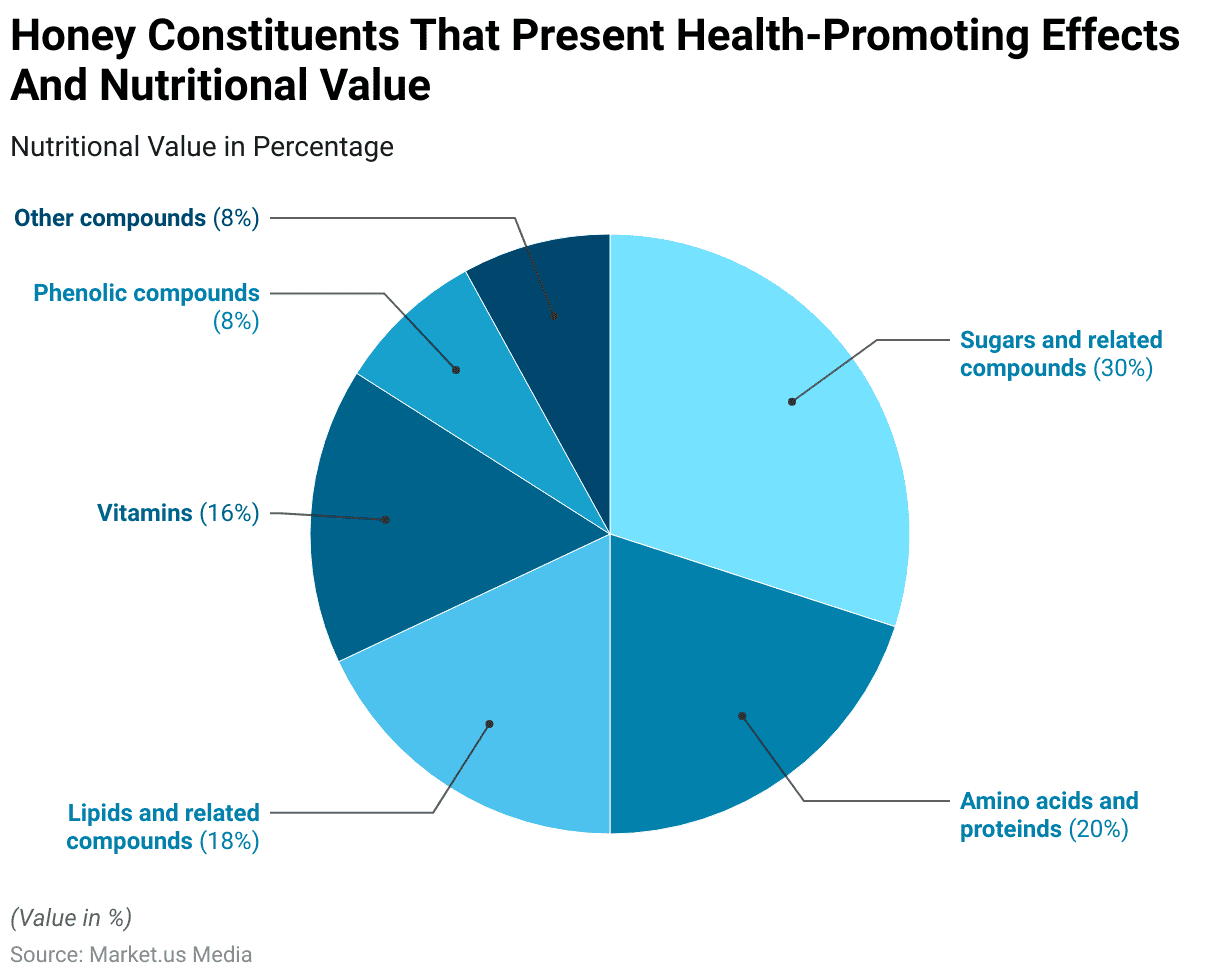
Top Consumers of Honey in The World
- The consumption of honey per capita varies significantly across different countries. The Central African Republic leads the list by a considerable margin, with its citizens consuming an average of 9.62 grams of honey daily.
- New Zealand follows closely in second place, where the daily per capita consumption stands at 5.55 grams, reflecting the popularity of honey in the region.
- Slovenia ranks third with an average daily intake of 4.4 grams, showcasing a notable appreciation for honey among its population.
- Greece and Switzerland also display a fondness for honey. With daily per capita consumption figures of 4.24 grams and 3.87 grams, respectively.
- Austria, Turkey, Ukraine, Slovakia, and Montenegro complete the top ten list, each showing a consistent preference for honey with daily per capita consumption ranging from 3.01 to 3.62 grams.
- These statistics provide insight into the varying levels of honey consumption habits among nations, influenced by cultural preferences and dietary choices.
(Source: FAOSTAT)

Honey Production Statistics
- As per the Food and Agriculture Organization of the United Nations (FAO). Global honey production per person saw a significant 42.9% rise from 1961 to 2017.
- At a worldwide scale, honey production per individual increased by 15.6%. Going from 218 kilograms per 1000 people in 1961 to 252 kilograms per 1000 people in 2017.
- This increase was most notable in Asia and South America, while Oceania experienced a considerable decline, and Africa, Europe, and North America saw relatively smaller decreases.
(Source: Nature)
Leading Natural Honey-Producing Nations
- In 2021, the global production of natural honey was led by China. Emerging as the undisputed leader with an impressive production volume of 472.7 thousand metric tons.
- China’s significant contribution to the honey industry underscores its vast agricultural resources and expertise.
- Following China, Turkey secured the second position with a production of 96.34 thousand metric tons, a notable presence in the global honey market.
- Iran, Argentina, and Ukraine also made substantial contributions with honey production figures of 77.15 thousand metric tons, 71.32 thousand metric tons, and 68.56 thousand metric tons, respectively.
- India, Russia, Brazil, Canada, and the Republic of Korea also featured prominently among the leading global honey producers. Each produces substantial quantities ranging from 55.38 thousand to 66.28 thousand metric tons.
- These statistics reflect the diverse geographical distribution of honey production worldwide, with China leading the pack in this vital industry.
(Source: Statista)
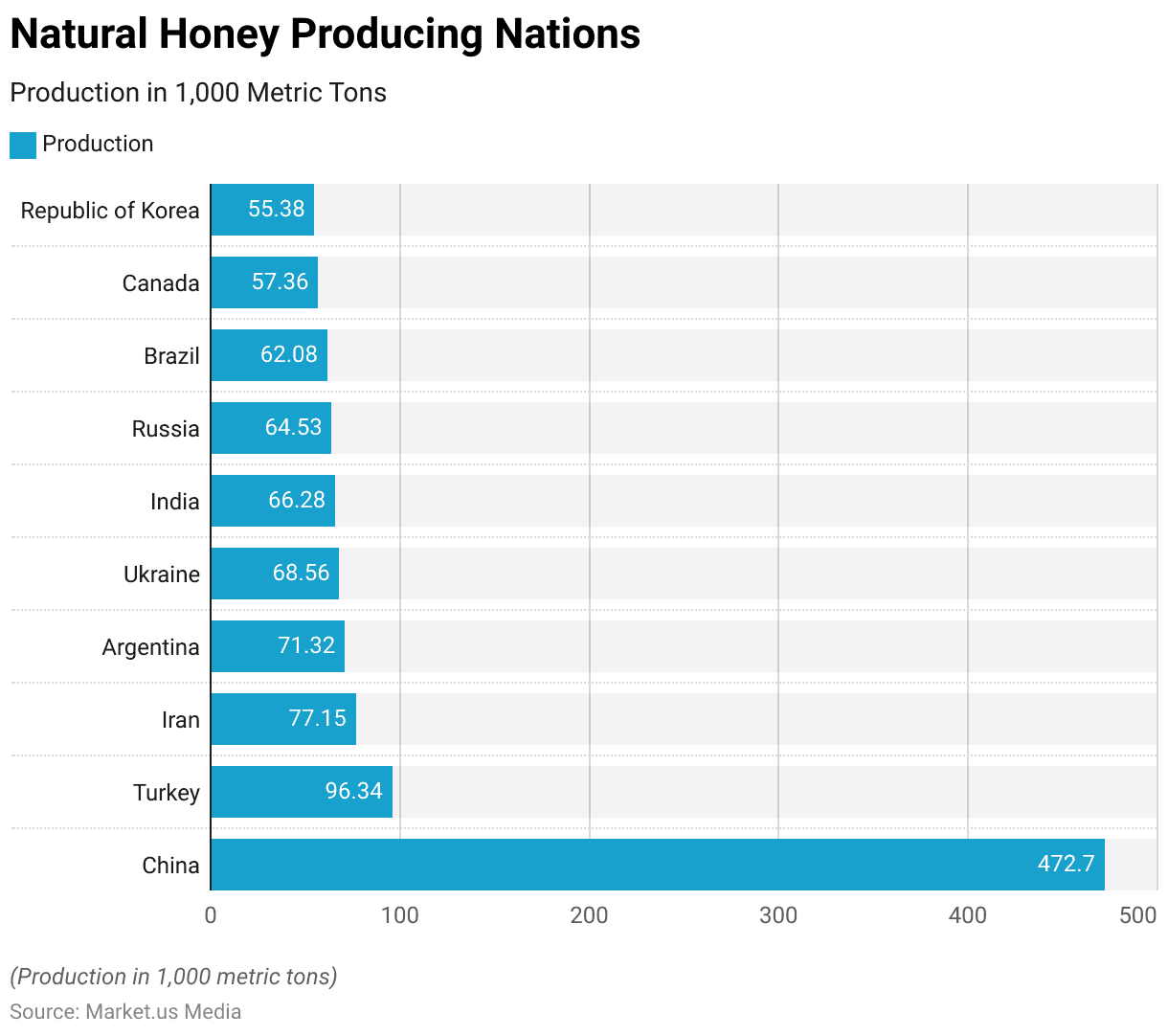
Leading Honey Exporting Nations
- In terms of honey exports, several countries made significant contributions to the global market in 2022.
- China led the way with an impressive export value of USD 277.7 million. Highlighting its prominence as a major exporter of honey products.
- New Zealand closely followed, securing the second position with an export value of USD 265.9 million, known for its high-quality honey offerings.
- Argentina also played a substantial role, with honey exports totaling USD 243.2 million, showcasing its presence in the global honey trade.
- India, with an export value of USD 229.3 million, demonstrated a robust position in the international market, driven by its diverse honey production.
- Germany, Ukraine, and Brazil each contributed USD 148.4 million, USD 137.9 million, and USD 137.9 million, respectively, underlining their roles as key exporters.
- Spain, Mexico, and Hungary, with export values of USD 117.5 million, USD 109.1 million, and USD 83.4 million, rounded out the list of prominent honey-exporting nations.
- These statistics illustrate the global nature of the honey trade, with multiple countries actively participating and contributing to its dynamics.
(Source: Tridge)

Leading Honey Import Nations Statistics
- In 2021, several countries emerged as major importers of natural honey, reflecting the global demand for this sweet commodity.
- Leading the list was the United States (U.S.A) with an impressive import quantity of 220,232 metric tonnes and a corresponding value of USD 667 million.
- Germany followed as a significant honey importer, bringing in 82,529 metric tonnes valued at USD 338 million.
- Japan and the United Kingdom (UK) secured the third and fourth positions with imports of 47,132 metric tonnes and 46,863 metric tonnes, valued at USD 170 million and USD 135 million, respectively.
- France and Italy also stood out as substantial importers, with honey quantities of 29,279 metric tonnes and 23,586 metric tonnes. Accompanied by import values of USD 121 million and USD 108 million, respectively.
- Notably, China (People’s Republic of China) imported 4,809 metric tonnes of honey, with a total value of USD 105 million.
- Poland, Saudi Arabia, and Spain rounded out the list of major honey importers, with quantities ranging from 21,187 to 37,594 metric tonnes. It has corresponding import values between USD 83 million and USD 91 million.
- These figures underscore the global reach and diverse consumer preferences for natural honey across various countries. Highlighting the significance of the honey trade on an international scale.
(Source: Agri Exchange)
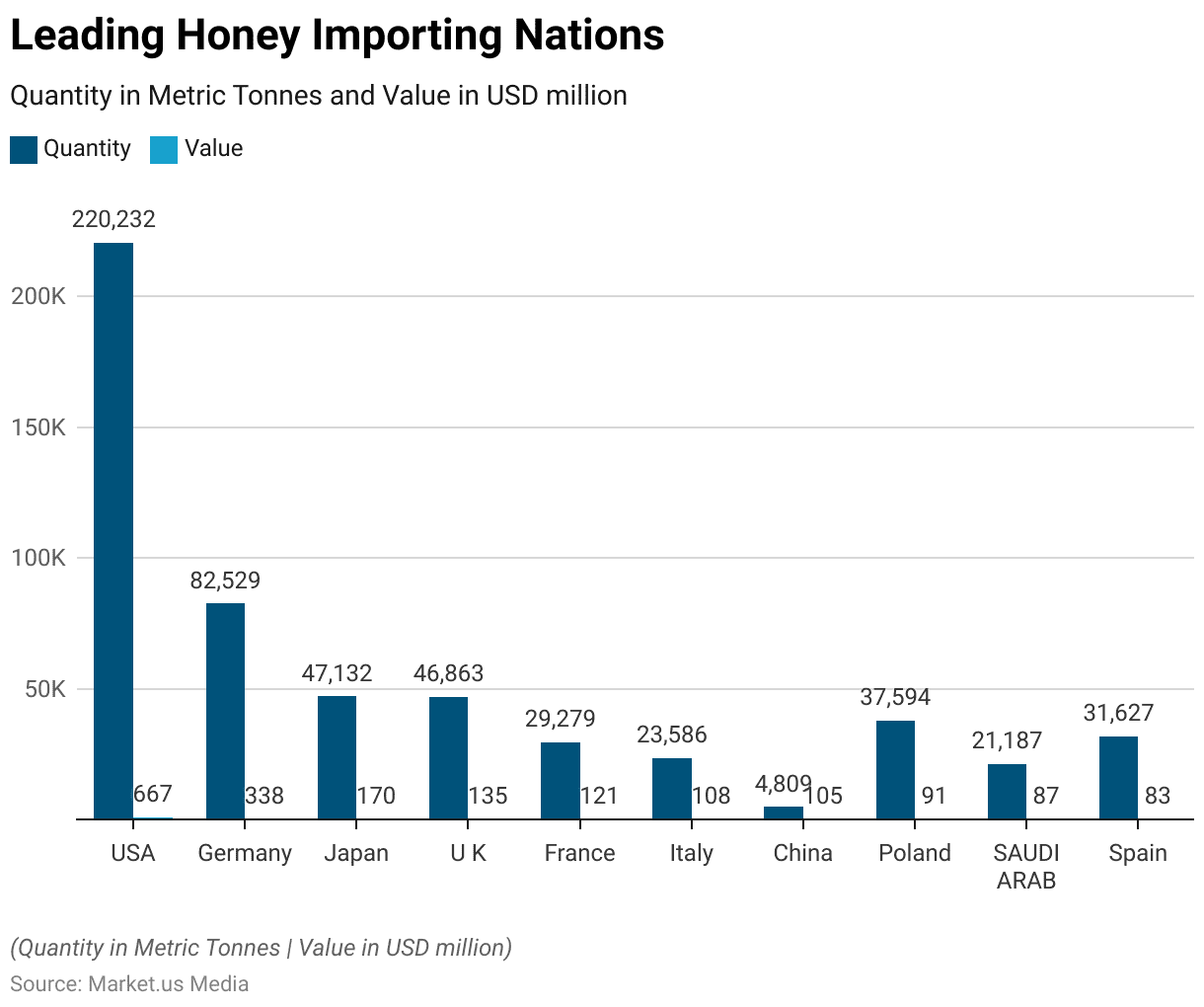
Regulatory Guidelines for Honey
- The Codex Alimentarius Commission has established 15 parameters concerning honey standards. For instance, the moisture content in honey, except for heather honey, should not exceed 20%.
- Another important parameter is the sucrose content, which can indicate adulteration and should not exceed 5 grams per 100 grams of honey, as outlined by the International Centre for Integrated Mountain Development (ICIMOD) in 2012.
- In more developed regions like the European Union (EU) and the United States (US), non-tariff measures (NTMs) tend to be stricter compared to the CODEX standards.
- This is also true for honey, where their NTMs appear to be more stringent than the CODEX safety guidelines. For example, the EU does not establish maximum residue levels (MRLs) for antibiotics in honey, which means antibiotics cannot be used for treating honey bees.
- However, EU member states continue to import honey, and for the regulation of residues in honey, the EU has set provisional MRLs. These include 25 parts per billion (ppb) for oxytetracycline, 0.3 ppb for chloramphenicol, and 1.0 ppb for nitrofurans.
- This represents a departure from the EU’s usual NTMs applied to honey products.
(Source: Trade Promotion Council of India)
Recent Developments
Mergers and Acquisitions:
- In January 2022, Sweet Harvest Foods Inc. acquired McKinney-based Nature Nate’s Honey Co., aiming to expand its presence in the natural sweeteners market.
- Dutch Gold Honey’s Acquisition by Wedderspoon Organic: Wedderspoon Organic, a leading producer of manuka honey products, acquired Dutch Gold Honey, a well-established honey supplier based in the United States.
- This strategic acquisition enhances Wedderspoon Organic’s product portfolio and market presence, positioning the company as a major player in the global honey industry. The acquisition deal was valued at $30 million, reflecting the growing consolidation within the honey market.
Product Launches and Innovations:
- In March 2023, Comvita Limited launched “Comvita Kids Yummy Honey” along with the Comvita UMF 5+ Honey Squeeze bottles to attract young consumers.
- Dabur launched ‘Dabur Honey Tasties’ in July 2021, a healthier alternative to classic syrups with no added sugar.
- Nature Nate’s Launch of Organic Honey Infusions: Nature Nate’s, a renowned honey brand, introduced a new line of organic honey infusions, featuring unique flavor combinations like cinnamon turmeric, and vanilla bean.
- These innovative products cater to consumers seeking natural and flavorful honey options for use in cooking, baking, and beverage enhancement.
- Within the first month of their launch, sales of Nature Nate’s organic honey infusions exceeded 500,000 units, indicating strong consumer interest in premium honey products.
Technological Advancements:
- Companies are increasingly focusing on technological innovations to ensure the authenticity and purity of their honey products. This includes testing methods for detecting adulteration and improving honey extraction efficiency through automation
Quality Assurance and Traceability:
- Implementation of Honey Authentication Technologies: With concerns over honey adulteration and counterfeit products on the rise, honey producers are investing in advanced authentication technologies to verify the authenticity and quality of their products.
- Techniques such as nuclear magnetic resonance (NMR) spectroscopy and stable isotope analysis enable accurate identification of honey origin and composition, providing consumers with assurance of product integrity and traceability throughout the supply chain.
Conclusion
Honey Statistics – To sum up, honey is a valuable natural product created by bees from flower nectar. It’s mainly composed of glucose and fructose, along with water and natural elements, with its distinct flavor influenced by the flowers bees visit.
Honey serves as a sweetener in cooking, offers potential health benefits, and is used in cosmetics and culinary preparations.
The global honey market is on an upward trajectory due to increased consumer awareness of its advantages.
International standards and regulations, like those from the Codex Alimentarius Commission and regional entities like the European Union, ensure honey quality and safety. Honey continues to be a cherished and versatile resource with a promising future.
FAQs
Honey is a natural sweet substance produced by honeybees from flower nectar. It is a viscous liquid with a unique flavor and various uses.
Bees collect nectar from flowers using their proboscis (tongue) and store it in their honey stomach. They then transform the nectar into honey through a process involving enzymes and moisture reduction in the hive.
Honey comes in various types, each with a distinct flavor profile based on the flowers bees visit. Some common types include wildflower honey, clover honey, and Manuka honey.
Yes, honey is a natural sweetener. It contains sugars like glucose and fructose, providing sweetness without the need for additional processing.
Honey has been used for its potential health benefits, including soothing sore throats, aiding in wound healing, and acting as an antioxidant. However, its health effects can vary depending on factors like its quality and use.
Discuss your needs with our analyst
Please share your requirements with more details so our analyst can check if they can solve your problem(s)



